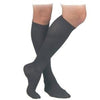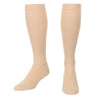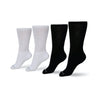When should I be worried about sock marks on my legs?

Table Of Contents:
Let’s be honest—most don’t spend much time thinking about our feet. But they do a lot for us daily and deserve a little love, too. A straightforward way to keep them happy? Wearing the right socks.
Socks do more than keep feet warm. They help prevent blisters, regulate temperature, and add a layer of protection between your skin and your shoes. For people with diabetes or circulation issues, the right pair of socks can make a huge difference in overall comfort and health.
But what about those sock lines you sometimes see at the end of the day—those reddish grooves left behind on your ankles? Are they just from tight socks, or could they be something to pay attention to?
So... Are Sock Marks Normal?
In most cases, yes. If you've been on your feet all day or your socks have a snug elastic band, it’s not unusual to see a faint line when you take them off. It’s like the mark your glasses leave on your nose—annoying but usually harmless.
Things like heat, salty foods, standing or sitting too long, or having sensitive skin can all make these marks slightly more noticeable. If they go away quickly and your feet feel fine, there’s no need to worry.
When to Take Sock Marks More Seriously
On the flip side, if those marks are showing up frequently, sticking around longer, or showing up alongside swelling or discomfort, that could be your body trying to tell you something.
Here are a few things that might be going on:
1. Swelling (a.k.a. Edema)
If your ankles or feet puff up and your socks leave deeper marks than usual, it could be fluid buildup. Sometimes, it’s nothing major—like standing too long or hot weather—but sometimes, it points to something deeper, like heart, liver, or kidney issues.
2. Dehydration
Oddly enough, not drinking enough water can lead to swelling. Dehydration affects blood vessels, and when they’re not working properly, fluid leaks into tissues—especially in the lower legs and feet.
3. Pregnancy
Pregnancy brings all sorts of changes, and swelling is common—especially in the later months. Most of the time, it’s harmless, but if it comes on suddenly or is uncomfortable, it’s worth checking in with your doctor.
4. Circulation Issues
Conditions like venous insufficiency or varicose veins can make it harder for blood to flow back up from your legs to your heart. The result? Achy legs, visible veins, swelling, and deeper sock marks.
5. High Blood Pressure
When blood pressure is high, circulation suffers. Fluid pools in feet and ankles, making sock lines more obvious.
6. Heart, Kidney, or Liver Trouble
These organs all help regulate fluids in your body. If one isn’t working quite right, swelling in the legs can be one of the first signs that something’s off.
7. Lung Conditions
Believe it or not, issues like COPD can affect your heart and fluid balance, too. If you’re noticing swelling along with trouble breathing, coughing, or fatigue, don’t brush it off.
8. Side Effects from Meds
Some medications—like certain antidepressants, blood pressure meds, and diabetes drugs—can cause swelling in the legs. Chat with your doctor if you think your meds might be playing a role.
Ways to Reduce Sock Marks (and Help Your Legs Feel Better)
If sock marks are starting to bother you—or you want to take better care of your feet and legs—here are some easy changes that can help:
-
Switch to better socks: Look for non-binding or compression socks, like the ones from Diabetic Sock Club. They offer just the right amount of support without digging into your skin.
-
Kick your feet up: Literally. Elevating your legs above heart level for 15–20 minutes can help move fluid out of your legs.
-
Move around more: Take breaks if you sit or stand a lot. Even small movements—like ankle rolls—can boost circulation.
-
Drink water & go easy on salt: Staying hydrated and cutting back on salty snacks can reduce fluid retention.
-
Massage and compression: Gently massaging your legs or wearing compression socks can keep things moving and help with swelling.
When to Check In with a Doctor
A slight swelling isn’t unusual now and then—especially after a long day or flight. But it's worth checking out if your feet and ankles are swelling often or if the sock marks are getting deeper and sticking around longer.
Also, if swelling comes with other symptoms like tiredness, shortness of breath, high blood pressure, or blurry vision—don’t wait. It could be a sign of something more serious.
Your doctor might run a few tests (blood work, ultrasounds, maybe an EKG or chest X-ray) to figure out what’s going on. The sooner you catch an issue, the easier it is to treat.
Final Thoughts
Sock marks on their own aren’t always something to stress about. But your body has ways of whispering when something’s off—sometimes even through something as small as a line on your ankle.
Please pay attention to the signs, and when in doubt, check it out.
And if you’re looking for socks that are good for your circulation but are not working against it, Diabetic Sock Club’s compression and diabetic socks are designed with your health and comfort in mind. They’re made in the USA, built for all-day wear, and gentle on your legs.
Because taking care of your feet is one small step toward taking care of your whole self.
1 comment
Best Sellers
-
Men's Cotton Diabetic Crew Socks (6 Pair)
![]()
- Regular price
- $39.99
- Sale price
- $39.99
- Regular price
-
$79.95 - Unit price
- per
Sold out





-
Men's Ultra-Soft Upper Calf Diabetic Socks (4 Pair)
![]()
- Regular price
- from $39.99
- Sale price
- from $39.99
- Regular price
-
$79.95 - Unit price
- per
Sold out


-
Men's Cotton Diabetic Ankle Socks (6 Pair)
![]()
- Regular price
- $39.99
- Sale price
- $39.99
- Regular price
-
$69.95 - Unit price
- per
Sold out


-
Women's Cotton Diabetic Crew Socks (6 Pair)
![]()
- Regular price
- $39.99
- Sale price
- $39.99
- Regular price
-
$79.95 - Unit price
- per
Sold out




-
Women's Cotton Diabetic Ankle Socks (6 Pair)
![]()
- Regular price
- $39.99
- Sale price
- $39.99
- Regular price
-
$79.95 - Unit price
- per
Sold out


-
Men's Over The Calf Compression Stocking Socks (1 Pair)
![]()
- Regular price
- from $19.99
- Sale price
- from $19.99
- Regular price
-
$31.95 - Unit price
- per
Sold out





-
Women's Ultra-Soft Upper Calf Diabetic Socks (4 Pair)
![]()
- Regular price
- from $39.99
- Sale price
- from $39.99
- Regular price
-
$79.95 - Unit price
- per
Sold out


-
DSC Hemp Cream For Neuropathy Aches & Nerve Pain (Peppermint)
![DSC Rub]()
- Regular price
- from $39.99
- Sale price
- from $39.99
- Regular price
-
$59.95 - Unit price
- per
Sold out










Dear Friends:
I learned from a Podiatrist friend, in the 1970’s, to wear only leather insoles – and only cotton socks which now are increasingly difficult to locate. I was very happy to find your socks.
For the past few years I have had foot and ankle edema, which I had assumed was due to my age and circulatory or kidney problems related to that. More recently, I learned that what I have is probably lymphedema, related to surgery many years ago which involved removal of inguinal lymph nodes.
I find that your socks still leave me with slight circular indentations from the elastic – and some swelling below that. Perhaps you might develop a new sock with looser elastic. Of course, they would tend to fall down, so I wonder if you could modify them by incorporating a few (six?) vertical “ribs” of more rigid (thicker?) cloth which would help them stay up.
I look forward to your reply.
Sincerely,
Ariel José Thomann, M.D.